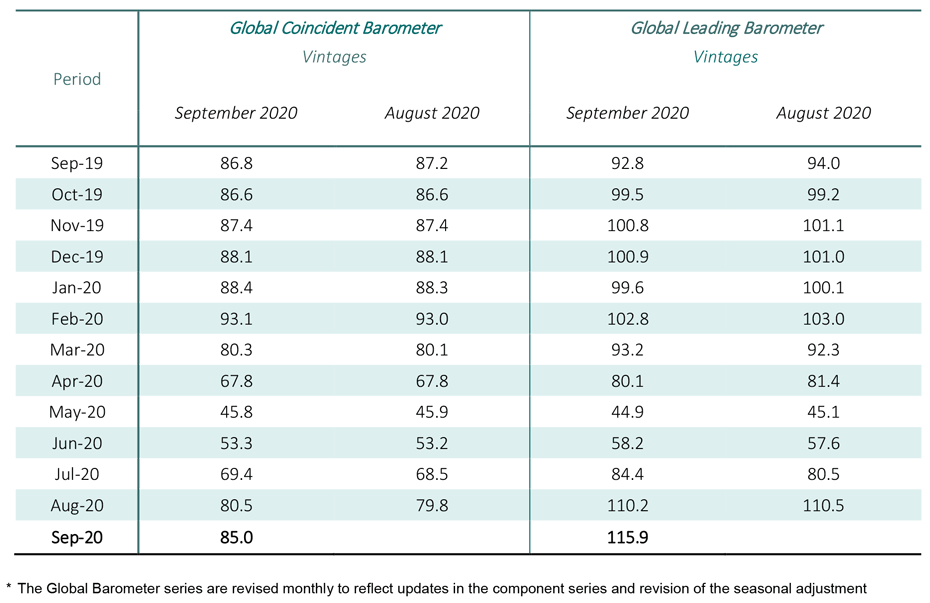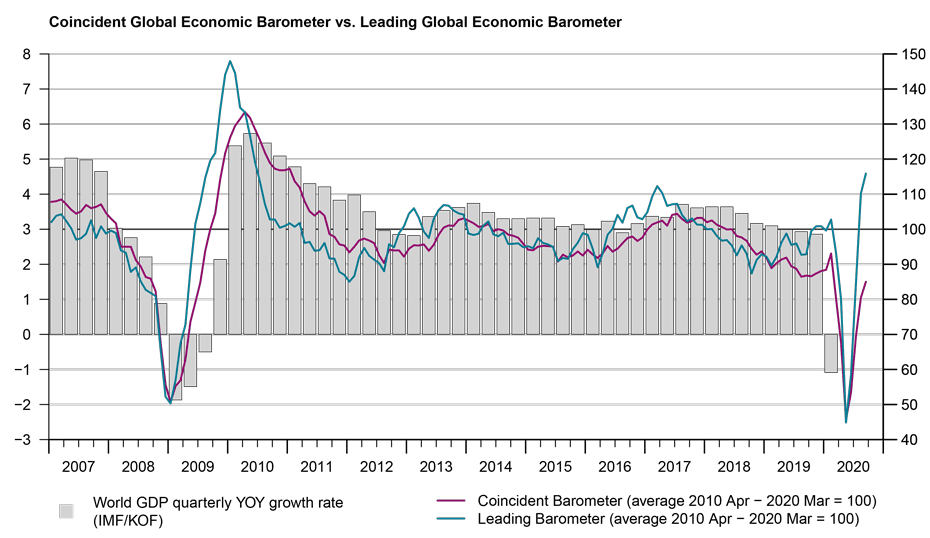Global Economic Barometers Maintain Upward Tendency
The Global Economic Barometers maintain their upward tendencies that began in May, after historic lows in April. The Coincident Barometer has reduced its upward pace and still reflects economic activity levels well below those before the Covid-19 pandemic. The Leading Barometer, on the other hand, reaches its highest level since 2010, signalling continued optimism regarding upcoming world GDP developments. Given the high levels of uncertainty, this should be interpreted with caution.
The Coincident Global Barometer records a rise of 4.5 points in September, increasing from 80.5 to 85.0 points. The Leading Global Barometer, meanwhile, rises 5.7 points this month, from 110.2 to 115.9 points. Albeit at a slower pace than before, both barometers have been rising for fourth months in a row now. Although all three regions investigated contribute positively to the movement of the Coincident Barometer, the Asia, Pacific and Africa region is taking the lead. In the Leading Barometer, the increase was influenced by Europe and the Western Hemisphere, while the Asia, Pacific and Africa region returned to contributing (slightly) negatively. The difference of 30.9 points between the two Barometers is the highest recorded in history, i.e. since 1991. This demonstrates the optimism regarding the future economic recovery relative to the current situation.
“The speed with which the world barometers fell early year and have recovered in recent months is higher than during the financial crisis. Although it is unclear when we will return to pre-crisis production levels, it does appear that so far it is more of a V-shaped type of crisis than what we have observed during any other world crisis in recent history” comments KOF-Director Jan-Egbert Sturm the latest results of the Global Barometers.
Coincident Barometer – regions and sectors
The Asia, Pacific and Africa region accounts for 61% of the growth in the Coincident Barometer in September, contributing 2.8 points to the rise of 4.5 points. The Europe and the Western Hemisphere (North America, Latin America and the Caribbean) regions both contribute 0.9 points to the global indicator. The Western Hemisphere is the first to return to its level of February 2020. The graph below illustrates the contribution of each region to the deviation of the Coincident Barometer from the historical average of 100 points.
The highest contribution to the increase in the Coincident Global Barometer once again comes from Industry, and, for the first time since the start of this health crisis, the second highest from Trade. The set of variables reflecting the aggregated evolution of economies (Overall Economic Development), which is usually more influential, comes in third place and contributes with less than 1.0 point this month. Services and Construction continue to contribute modestly to the result, with the latter exerting a negative influence.
Leading Barometer – regions and sectors
The Leading Global Barometer leads the world economic growth rate cycle by three to six months on average. In September, Europe contributes 6.2 points to the 5.7 points rise in the global indicator, in comparison with a stronger increase of 28.7 points in its Coincident Barometer. The Western Hemisphere indicator makes a slight, positive contribution, while Asia, Pacific and Africa falls, partly compensates the increase recorded in the other regions. This last region is the only one in which the leading indicator is yet to recover the losses that occurred between March and May of this year.
All sector indicators contribute positively to the result of the Leading Barometer, except for Construction. The Industry sector contributed more than 3.0 points and the set of variables reflecting the aggregated evolution of economies (Overall Economic Development) and the Services sector added a little over 1.0 point each. The remaining sectors contributed less significantly to the increase in the global leading indicator.

The full press release with table and graphs can be found Download here (PDF, 476 KB).
More information on the Global Economic Barometers can be found here.
The Global Economic Barometers
The Global Economic Barometers are a system of indicators that enables a timely analysis of global economic development. They represent a collaboration between the KOF Swiss Economic Institute of the ETH Zurich in Switzerland and Fundação Getulio Vargas (FGV) based in Rio de Janeiro, Brazil. The system consists of two composite indicators: a Coincident Barometer and a Leading Barometer. The Coincident Barometer reflects the current state of economic activity. The Leading Barometer, on the other hand, gives a cyclical signal that is roughly six months ahead of actual economic developments.
The two Barometers comprise the results of economic tendency surveys conducted in more than 50 countries. The aim is to achieve the broadest possible global coverage. Advantages of economic tendency surveys are that their results are usually available quickly and they are not substantially revised after the first publication.
The Coincident Barometer includes more than 1,000 different time series, while the Leading Barometer comprises over 600 time series. Cross-correlation analysis is used to decide which individual time series are included in the barometers. This involves correlating the individual time series with a reference series. The reference series used is the year-on-year growth rate of global gross domestic product (GDP), where the individual national GDPs are aggregated at purchasing power parity to form global GDP. A time series is only included in a Barometer if it shows a sufficiently high correlation and a suitable synchronisation or lead with the reference series.
The two Barometers are calculated once every month. They are usually published at the 10th of each calendar month. They are therefore available at a monthly frequency and in a timely manner.
